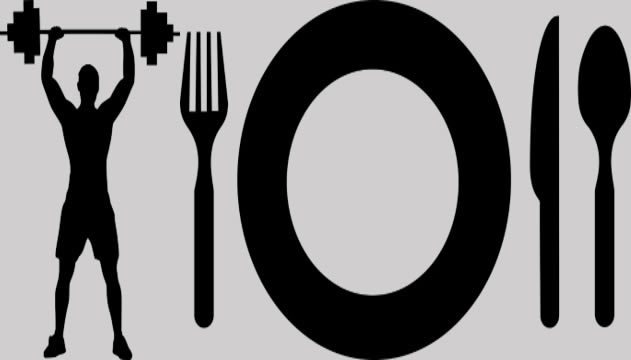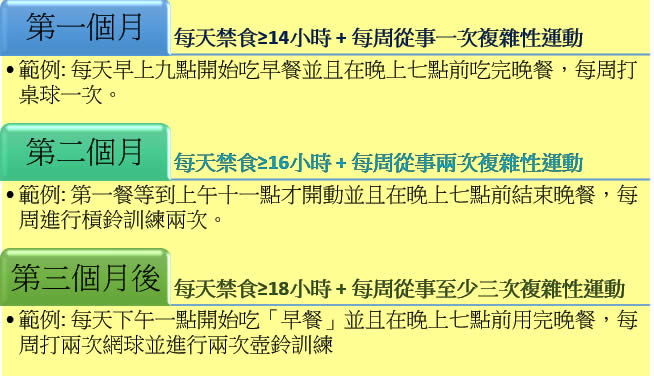
如何藉由運動與禁食促進大腦功能
文:林庭佑 博士生 / 國立臺灣師範大學
藉由前兩篇文章,我們了解了影響生物年齡的因子、生活習慣對健康的影響。
本篇將針對運動與禁食這兩個能夠有效保持大腦年輕的方法進行闡述,並於文末介紹要怎麼將兩者結合。
運動:不同的運動類型有不同的效果
我們的大腦就像肌肉一樣,要接受適當的刺激才能夠變得更加強健。給予大腦的刺激要達到良好的效果有兩個關鍵:「複雜」與「新穎」兩個要素 1,2。
運動除了可以改善生理健康,同時也會增加神經滋養因子 (BDNF) 的釋放3,進而使神經新生的數量上升 4。臺灣師範大學洪聰敏研究講座教授與臺灣大學洪巧菱副教授等人,在2018年發表的研究即發現在運動量相近的情況下,打羽球比起跑步更能夠促進血清中的BDNF濃度的上升 5。由此可見,學習一項包含了複雜動作的運動,例如:持拍運動 (桌球、網球、羽球) 可能會對大腦有更好的幫助。
「阻力訓練」除了可以提升肌肉量與肌力,同樣也能增加血中BDNF的濃度,但並非所有形式的阻力運動都能達到最佳的效果。自由重量(free-weight) 、多關節(multi-joint) 的阻力運動 (例如槓鈴、壺鈴)
除了對於身體功能比起器械式、單關節的動作有更大的幫助之外 6,7,綜合數篇過去的研究可以發現自由重量、多關節 8,9 而非單關節、器械式的阻力運動 10,11 才能夠顯著地提升血中BDNF的濃度
。兩者的差異可能來自於前者的動作更加複雜,因此需要投入更多的心智資源與徵招更多的肌肉參與12,13所致。
禁食:需要多久?
除了規律運動以外,間歇性禁食 (intermittent fasting) 一樣可以提升神經滋養因子的釋放,同時也能活化Notch等與神經元生長相關的訊息途徑 (signaling pathway),Baik等人在2020年發表的動物實驗顯示,只要每天禁食16個小時 持續三個月,海馬迴 (負責學習與記憶的腦區) 中就會有更多的新生神經元 14!
不論是規律運動或是禁食對於身體來說都是一種「良性壓力」,可以讓我們維持健康並對抗潛在疾病。禁食能夠促進健康的其中一個生理途徑,是藉由暫時停止攝取食物來限制細胞可以獲得的能量,而運動本身又能更進一步地增加能量的消耗,因此合併兩者能夠達到更好的效果 15!
該如何執行?
(註:此文章僅為提供資訊,非醫療建議,有任何疾病相關問題請與您的醫師討論)
一篇2019年發表在新英格蘭醫學期刊 15 的文獻給出「漸進式」的禁食處方,與平常我們所說運動要漸進式地增加負荷的概念相若。禁食和運動一樣需要練習與適應,剛開始時可以從晚一點吃早餐並且早一點吃晚餐 (並與消夜說再見) 起步。以下即為結合兩者而生的漸進式運動與禁食處方:
引用文獻
- Kempermann, G., Kuhn, H. G. & Gage, F. H. More hippocampal neurons in adult mice living in an enriched environment. Nature 386, 493-495 (1997).
- Ramirez-Amaya, V., Marrone, D. F., Gage, F. H., Worley, P. F. & Barnes, C. A. Integration of new neurons into functional neural networks. Journal of Neuroscience 26, 12237-12241 (2006).
- Vaynman, S., Ying, Z. & Gomez‐Pinilla, F. Hippocampal BDNF mediates the efficacy of exercise on synaptic plasticity and cognition. European Journal of Neuroscience 20, 2580-2590 (2004).
- Van Praag, H., Kempermann, G. & Gage, F. H. Running increases cell proliferation and neurogenesis in the adult mouse dentate gyrus. Nature neuroscience 2, 266-270 (1999).
- Hung, C.-L., Tseng, J.-W., Chao, H.-H., Hung, T.-M. & Wang, H.-S. Effect of acute exercise mode on serum brain-derived neurotrophic factor (BDNF) and task switching performance. Journal of clinical medicine 7, 301 (2018).
- Wirth, K., Keiner, M., Hartmann, H., Sander, A. & Mickel, C. Effect of 8 weeks of free-weight and machine-based strength training on strength and power performance. Journal of human kinetics 53, 201-210 (2016).
- Cussler, E. C. et al. Weight lifted in strength training predicts bone change in postmenopausal women. Medicine science in sports exercise 35, 10-17 (2003).
- Church, D. D. et al. Comparison of high intensity versus high volume resistance training on the BDNF response to exercise. Journal of Applied Physiology 121, 123-128 (2016).
- Yarrow, J. F., White, L. J., McCoy, S. C. & Borst, S. E. Training augments resistance exercise induced elevation of circulating brain derived neurotrophic factor (BDNF). Neuroscience letters 479, 161-165 (2010).
- Goekint, M. et al. Strength training does not influence serum brain-derived neurotrophic factor. European journal of applied physiology 110, 285-293 (2010).
- Correia, P. R. et al. Acute strength exercise and the involvement of small or large muscle mass on plasma brain-derived neurotrophic factor levels. Clinics 65, 1123-1126 (2010).
- Schick, E. E. et al. A comparison of muscle activation between a Smith machine and free weight bench press. The Journal of Strength & Conditioning Research 24, 779-784 (2010).
- Schwanbeck, S., Chilibeck, P. D. & Binsted, G. A comparison of free weight squat to Smith machine squat using electromyography. The Journal of Strength & Conditioning Research 23, 2588-2591 (2009).
- Baik, S. H., Rajeev, V., Fann, D. Y. W., Jo, D. G. & Arumugam, T. V. Intermittent fasting increases adult hippocampal neurogenesis. Brain and Behavior 10, e01444 (2020).
- de Cabo, R. & Mattson, M. P. Effects of Intermittent Fasting on Health, Aging, and Disease. New England Journal of Medicine 381, 2541-2551 (2019).







